A Look At Amazon’s, Netflix’s & Uber’s Business Models
by Will Williamson on 07-Sep-2018 14:40:56

What do all 3 of these companies have in common, other than raking in billions in profit each year?
They all have strong business models and have managed to dominate their own markets by adapting to changing customer demands as well as using technology to accelerate their own growth.
Whilst Amazon currently tops the list regarding profit, generating an eye-watering $52.9 billion in net sales during the second quarter of 2018 (https://www.statista.com/statistics/273963/quarterly-revenue-of-amazoncom/), all 3 companies show the true power of innovation and branding.
Amazon
The driving force of Amazon’s success has always been its ability to successfully enter new markets and quickly monopolise them. From its beginning as an online bookseller, Amazon has now expanded into different categories to suit differing customer demands. However, its biggest earner still remains within retail, due mainly to Amazon’s reputation and ability to negotiate cheaper deals with wholesalers.
Amazon Marketplace allows users to sell their own products using Amazon’s already established platform and loyal consumers. Not only does Amazon cleverly target a new customer in this way - i.e., the seller - Amazon also encourages sellers to opt in for paid advertising to boost the exposure of their products. Amazon takes a percentage of each sale in commission, as a further way of generating revenue from its sellers.
Amazon has also branched out into providing web services like cloud computing whilst Amazon Prime has revolutionised the streaming of music, videos and movies. Amazon Prime also offers customers access to audiobooks, photo-storage, a Kindle library and free 2-day shipping. Not to mention, it has been Amazon’s way of competing with the hugely successful Netflix.
Netflix
Allowing customers to subscribe to their video-streaming and DVD services, Netflix puts a huge focus on developing customer loyalty. Users can cancel their membership at any time, so the fundamental element of Netflix’s business model is building quality for the customer.
Netflix utilises data analytics to understand customer behaviour, allowing them to tailor-make personalised recommendations for each customer. By also expanding its film production through Netflix Original programmes, Netflix is successfully ensuring customers will continue to subscribe to access their exclusive content.
Uber
By identifying a gap in the market and developing a business model around it, Uber’s success is in their fast, convenient, competitively priced taxi services.
Uber’s foundation rests upon the usability of their app, which eliminates the need for cash payments. Uber has also reduced their own costs by regarding drivers as self-employed instead of employees - a move which has caused some legal stipulation to employment rights, meaning all cabs are owned and maintained by the drivers.
Uber’s main profit is within its surge pricing concept, where the fare is determined by distance, time and demand, increasing during peak periods. By also branching out into the food delivery system UberEats, Uber is successfully targeting a new customer market, whilst taking a sizeable cut of between 20-25% of each fare (https://www.feedough.com/uber-business-model/).
The Strength Is In The Plan, Not Just The Execution
All 3 companies have risen to success through the careful planning and constant re-evaluation of their business models. By identifying customer needs and quickly adapting their businesses to cater towards them, Amazon, Uber and Netflix have shown the power of being innovative and flexible in business.

- Inbound Marketing (SEO, PPC, Social Media, Video) (824)
- Strategy (363)
- Sales & CRM (195)
- Marketing Automation & Email Marketing (190)
- Business Growth (164)
- Website Design (160)
- Hubspot (138)
- Lead Generation (115)
- Google Adwords (98)
- Content Marketing (94)
- Conversion (48)
- Case Studies (47)
- News (47)
- Ecommerce (39)
- Webinars (34)
- SEO (24)
- AI (20)
- Events (19)
- Video (17)
- LinkedIn Advertising (15)
- Video Selling (15)
- Software training (13)
- Niche business marketing (11)
- The Digital Prosperity Podcast (10)
- Facebook Advertising (6)
- HubSpot Case Studies (5)
- December 2025 (10)
- November 2025 (6)
- October 2025 (17)
- September 2025 (16)
- August 2025 (14)
- July 2025 (14)
- June 2025 (5)
- May 2025 (19)
- April 2025 (15)
- March 2025 (13)
- February 2025 (13)
- January 2025 (8)
- December 2024 (2)
- November 2024 (4)
- October 2024 (21)
- September 2024 (4)
- August 2024 (8)
- July 2024 (14)
- June 2024 (16)
- May 2024 (25)
- April 2024 (15)
- March 2024 (18)
- February 2024 (5)
- January 2024 (10)
- December 2023 (6)
- November 2023 (10)
- October 2023 (13)
- September 2023 (12)
- August 2023 (14)
- July 2023 (13)
- June 2023 (14)
- May 2023 (15)
- April 2023 (13)
- March 2023 (14)
- February 2023 (13)
- January 2023 (15)
- December 2022 (13)
- November 2022 (6)
- October 2022 (8)
- September 2022 (22)
- August 2022 (15)
- July 2022 (13)
- June 2022 (16)
- May 2022 (14)
- April 2022 (16)
- March 2022 (17)
- February 2022 (11)
- January 2022 (8)
- December 2021 (6)
- November 2021 (7)
- October 2021 (11)
- September 2021 (10)
- August 2021 (7)
- July 2021 (7)
- June 2021 (4)
- May 2021 (4)
- April 2021 (1)
- March 2021 (3)
- February 2021 (5)
- January 2021 (4)
- December 2020 (7)
- November 2020 (6)
- October 2020 (5)
- September 2020 (9)
- August 2020 (18)
- July 2020 (17)
- June 2020 (17)
- May 2020 (10)
- April 2020 (21)
- March 2020 (24)
- February 2020 (21)
- January 2020 (12)
- December 2019 (23)
- November 2019 (12)
- October 2019 (14)
- September 2019 (16)
- August 2019 (15)
- July 2019 (13)
- June 2019 (6)
- May 2019 (8)
- April 2019 (4)
- March 2019 (2)
- February 2019 (2)
- January 2019 (2)
- December 2018 (3)
- November 2018 (24)
- September 2018 (11)
- August 2018 (9)
- June 2018 (3)
- May 2018 (6)
- April 2018 (14)
- March 2018 (12)
- February 2018 (16)
- January 2018 (15)
- December 2017 (15)
- November 2017 (18)
- October 2017 (23)
- September 2017 (19)
- August 2017 (28)
- July 2017 (27)
- June 2017 (25)
- May 2017 (18)
- April 2017 (17)
- March 2017 (16)
- February 2017 (17)
- January 2017 (14)
- December 2016 (21)
- November 2016 (27)
- October 2016 (25)
- September 2016 (16)
- August 2016 (20)
- July 2016 (19)
- June 2016 (14)
- May 2016 (20)
- April 2016 (24)
- March 2016 (22)
- February 2016 (28)
- January 2016 (27)
- December 2015 (28)
- November 2015 (19)
- October 2015 (9)
- September 2015 (12)
- August 2015 (5)
- July 2015 (1)
- June 2015 (10)
- May 2015 (3)
- April 2015 (11)
- March 2015 (14)
- February 2015 (15)
- January 2015 (12)
- December 2014 (2)
- November 2014 (23)
- October 2014 (2)
- September 2014 (2)
- August 2014 (2)
- July 2014 (2)
- June 2014 (7)
- May 2014 (14)
- April 2014 (14)
- March 2014 (7)
- February 2014 (2)
- January 2014 (7)
- December 2013 (9)
- November 2013 (14)
- October 2013 (17)
- September 2013 (3)
- August 2013 (6)
- July 2013 (8)
- June 2013 (4)
- May 2013 (3)
- April 2013 (6)
- March 2013 (6)
- February 2013 (7)
- January 2013 (5)
- December 2012 (3)
- November 2012 (2)
- September 2012 (1)
Subscribe by email
You May Also Like
These Related Blogs

7 Takeaways From HubSpot's Dublin #partnersummit18
Last week myself and our MD, David Roberts, were in Dublin for the EMEA HubSpot partner summit. Hosted at Croke Park, this annual event brings togethe …

Social Media Sharing Behaviour - Important Stats You Need To Know
Social media has now become a part of our daily lives. In fact, many businesses are now recognising it as more than just a social platform, but also a …

Case Study: Specialist Welding Company Goes Beyond SEO To Develop Full Inbound Marketing System
In 2016 we met with a specialist welding company (machinery, tooling & welding services). They had been using SEO as their only real marketing cha …


